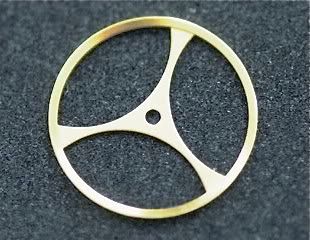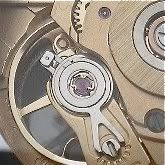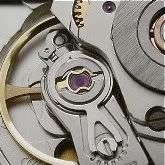Smoke and Mirrors - part 1 (ETA grades explained)
We all learn early on in our watch collecting careers that it's common practice for companies to rename an ETA movement with their own model number after they modify it. It's an exercise that's been going on for years with more than just ETA products. Longines used Valjoux 72 chronograph movements under their code of 330 or 332, Cyma 380 automatics were renamed the Longines 480, and Marvin 700 series became their caliber 490. Omega used a Lemania chronograph movement for their famous calibers 321 and 861, and still use one as a base for their modern 1861. Breitling also employs Lemania movements for some of their modern manual wind watches, calling it the B12; they also used various Valjoux chronographs including the Valjoux 72 in their early Navitimers. So it's a fact that many brands are using 'customized' ETA movements inside their watches nowadays..... but what do they really do to upgrade them? Let's have a look.
Valjoux 7736 inside a vintage Breitling
But before we get into individual companies and movements, there's some basic information you need to know. ETA sells their ebauchés in 4 grades, and not all of the grades are offered for every movement. They are Standard, Elaboré, Top, and Chronometre. The Valjoux 7750 does not come in the Standard Grade. Each grade has set performance parameters, and 95% of the ebauchés delivered in a lot must be within these limits.
Standard
adjusted in 2 positions: CH and 6H (click HERE for details on positional timekeeping terminology)
average daily rate: +/- 12 seconds
maximum positional variation: 30 seconds
isochronism between 0 and 24 hours: +/- 20 seconds
Elaboré
adjusted in 3 positions: CH, 6H, 9H
average daily rate: +/- 7 seconds
maximum positional variation: 20 seconds
isochronism between 0 and 24 hours: +/- 15 seconds
Top
adjusted in 5 positions: CH, FH, 6H, 9H, 3H
average daily rate: +/- 4 seconds
maximum positional variation: 15 seconds
isochronism between 0 and 24 hours: +/- 10 seconds
Chronometre
adjusted and timed per COSC specification (see above link under Standard) which is not much different from Top Grade
There are also upgraded parts made with different alloys and materials in the higher grades. The Standard and Elaboré calibers use Etachoc shock protection, a nickel balance wheel with a Nivarox 2 alloy hairspring, a Nivaflex NO mainspring, a steel pallet lever and escape wheel, and polyruby pallet jewels. The Top and Chronometre calibers use Incabloc shock protection, a Glucydur balance wheel with an Anchron alloy hairspring, a Nivaflex NM mainspring, a Nivarox pallet lever and escape wheel, and ruby pallet jewels.
Explaining the advantage of a Glucydur balance over a nickel balance is simple: Glucydur (or beryllium bronze) resists deformation from temperature change or abuse much better than nickel so the balance wheel stays in balance and therefore keeps more consistent time.
Glucydur balance wheel
As far as the hairspring materials, there are 5 Nivarox versions - 1 being the highest grade, 5 being the lowest. The difference lies in the consistency of the timekeeping performance due to small changes in the alloyed metals. Nivarox hairsprings consist of cobalt (42-48%), nickel (15-25%), chromium (16-22%), and small amounts of titanium and beryllium. Anachron is said to be a better performing alloy than any Nivarox incarnation which is why it's used on the Top and Chronometre grades. What metals Anachron consists of is another mystery. I've asked watchmakers here and in the real world and searched the internet for days without finding any information. ETA does also offer the option to upgrade from a Niravox 2 to a Niravox 1 hairspring with the nickel balance wheel on the lower two grades. (click HERE and HERE for more information on the balance & hairsping assembly)
Explaining the variance between Nivaflex NO and Nivaflex NM mainsprings is more difficult - the alloy formulation changes are a trade secret so information is scarce even to watchmakers. I'm not sure if there is much of a change between the two since both Nivarox alloys are listed as 45% cobalt, 21% nickel, 18% chromium, 5% iron, 4% tungsten, 4% molybdenum, and 1% titanium. Do the math and that leaves 2% unaccounted for and who knows what elements fill that void. The difference in the NO and NM might only be tempering the end of the spring and bridle, but that would be an educated guess. (click HERE for more information on mainsprings)
The difference between polyrubies and rubies is based in the manufacturing process. Polyrubies are made from powder that's heat pressed into shape. They're translucent, almost foggy. Rubies are cut from a man-made crystal that's formed in an electro-chemical process. They're completely transparent with better consistency. (click HERE and HERE for more on jewels and shock protection)
The change in shock protection from Etachoc to Incabloc is mostly about price. Incabloc costs more... but for a good reason. The Incabloc system is made entirely to in-house parameters instead of assembled from off the shelf pieces which is a real advantage on the quality control front. Even the jewels are custom made by Sietz (who have practically monopolized the jewel making industry) to Incabloc's specifications. It's also easier to service the Incabloc system. ETA does offer an upgrade to Incabloc on Standard and Elaboré calibers.
.Etachoc vs Incabloc
pictures by Johnny P
If you're curious, you can see illustrations of the dozens of different shock protection systems HERE.
If any watchmaker or other industry insider would like to clue us in on some of the other secretive alterations in materials we'd certainly like to hear from you.
I've picked out some of what I thought was the best comment- but I think it's worth going through yourselves
Does anyone really think that an Omega 7750, or an IWC 7750, or an ETA Chronometer 7750, or (insert chronometer brand here) 7750, are significantly different? And of course, since Omega and ETA are brothers, everyone knows that both of their 7750's come off the same bench, whether they say Omega or ETA.
If you're going to reveal in Part 2 that Breitling and IWCs, etc, come straight out of ETAs shop as chronometers, too, that shouldn't be all that surprising either. After all, how much can any brand really modify them? This isn't rocket science!
Truth is, it's part of the reason I don't own an IWC Spitfire Chrono, but instead own an Omega Speedmaster Date Chronometer; they both have essentially the same specs and I ask myself, "how different could the 7750s be?" (btw - I LOVE the spitfires, just struggle with the price difference)
Now, if IWC were casing up base 7750s and calling them "modified", THAT would be news (involving smoke and mirrors and deception).
Smoke and Mirrors - part 1 (ETA grades explained)
We all learn early on in our watch collecting careers that it's common practice for companies to rename an ETA movement with their own model number after they modify it. It's an exercise that's been going on for years with more than just ETA products. Longines used Valjoux 72 chronograph movements under their code of 330 or 332, Cyma 380 automatics were renamed the Longines 480, and Marvin 700 series became their caliber 490. Omega used a Lemania chronograph movement for their famous calibers 321 and 861, and still use one as a base for their modern 1861. Breitling also employs Lemania movements for some of their modern manual wind watches, calling it the B12; they also used various Valjoux chronographs including the Valjoux 72 in their early Navitimers. So it's a fact that many brands are using 'customized' ETA movements inside their watches nowadays..... but what do they really do to upgrade them? Let's have a look.
Valjoux 7736 inside a vintage Breitling
But before we get into individual companies and movements, there's some basic information you need to know. ETA sells their ebauchés in 4 grades, and not all of the grades are offered for every movement. They are Standard, Elaboré, Top, and Chronometre. The Valjoux 7750 does not come in the Standard Grade. Each grade has set performance parameters, and 95% of the ebauchés delivered in a lot must be within these limits.
Standard
Elaboré
Top
Chronometre
There are also upgraded parts made with different alloys and materials in the higher grades. The Standard and Elaboré calibers use Etachoc shock protection, a nickel balance wheel with a Nivarox 2 alloy hairspring, a Nivaflex NO mainspring, a steel pallet lever and escape wheel, and polyruby pallet jewels. The Top and Chronometre calibers use Incabloc shock protection, a Glucydur balance wheel with an Anchron alloy hairspring, a Nivaflex NM mainspring, a Nivarox pallet lever and escape wheel, and ruby pallet jewels.
Explaining the advantage of a Glucydur balance over a nickel balance is simple: Glucydur (or beryllium bronze) resists deformation from temperature change or abuse much better than nickel so the balance wheel stays in balance and therefore keeps more consistent time.
Glucydur balance wheel

As far as the hairspring materials, there are 5 Nivarox versions - 1 being the highest grade, 5 being the lowest. The difference lies in the consistency of the timekeeping performance due to small changes in the alloyed metals. Nivarox hairsprings consist of cobalt (42-48%), nickel (15-25%), chromium (16-22%), and small amounts of titanium and beryllium. Anachron is said to be a better performing alloy than any Nivarox incarnation which is why it's used on the Top and Chronometre grades. What metals Anachron consists of is another mystery. I've asked watchmakers here and in the real world and searched the internet for days without finding any information. ETA does also offer the option to upgrade from a Niravox 2 to a Niravox 1 hairspring with the nickel balance wheel on the lower two grades. (click HERE and HERE for more information on the balance & hairsping assembly)
Explaining the variance between Nivaflex NO and Nivaflex NM mainsprings is more difficult - the alloy formulation changes are a trade secret so information is scarce even to watchmakers. I'm not sure if there is much of a change between the two since both Nivarox alloys are listed as 45% cobalt, 21% nickel, 18% chromium, 5% iron, 4% tungsten, 4% molybdenum, and 1% titanium. Do the math and that leaves 2% unaccounted for and who knows what elements fill that void. The difference in the NO and NM might only be tempering the end of the spring and bridle, but that would be an educated guess. (click HERE for more information on mainsprings)
The difference between polyrubies and rubies is based in the manufacturing process. Polyrubies are made from powder that's heat pressed into shape. They're translucent, almost foggy. Rubies are cut from a man-made crystal that's formed in an electro-chemical process. They're completely transparent with better consistency. (click HERE and HERE for more on jewels and shock protection)
The change in shock protection from Etachoc to Incabloc is mostly about price. Incabloc costs more... but for a good reason. The Incabloc system is made entirely to in-house parameters instead of assembled from off the shelf pieces which is a real advantage on the quality control front. Even the jewels are custom made by Sietz (who have practically monopolized the jewel making industry) to Incabloc's specifications. It's also easier to service the Incabloc system. ETA does offer an upgrade to Incabloc on Standard and Elaboré calibers.
.Etachoc vs Incabloc


pictures by Johnny P
If you're curious, you can see illustrations of the dozens of different shock protection systems HERE.
If any watchmaker or other industry insider would like to clue us in on some of the other secretive alterations in materials we'd certainly like to hear from you.
I've picked out some of what I thought was the best comment- but I think it's worth going through yourselves
Does anyone really think that an Omega 7750, or an IWC 7750, or an ETA Chronometer 7750, or (insert chronometer brand here) 7750, are significantly different? And of course, since Omega and ETA are brothers, everyone knows that both of their 7750's come off the same bench, whether they say Omega or ETA.
If you're going to reveal in Part 2 that Breitling and IWCs, etc, come straight out of ETAs shop as chronometers, too, that shouldn't be all that surprising either. After all, how much can any brand really modify them? This isn't rocket science!
Truth is, it's part of the reason I don't own an IWC Spitfire Chrono, but instead own an Omega Speedmaster Date Chronometer; they both have essentially the same specs and I ask myself, "how different could the 7750s be?" (btw - I LOVE the spitfires, just struggle with the price difference)
Now, if IWC were casing up base 7750s and calling them "modified", THAT would be news (involving smoke and mirrors and deception).